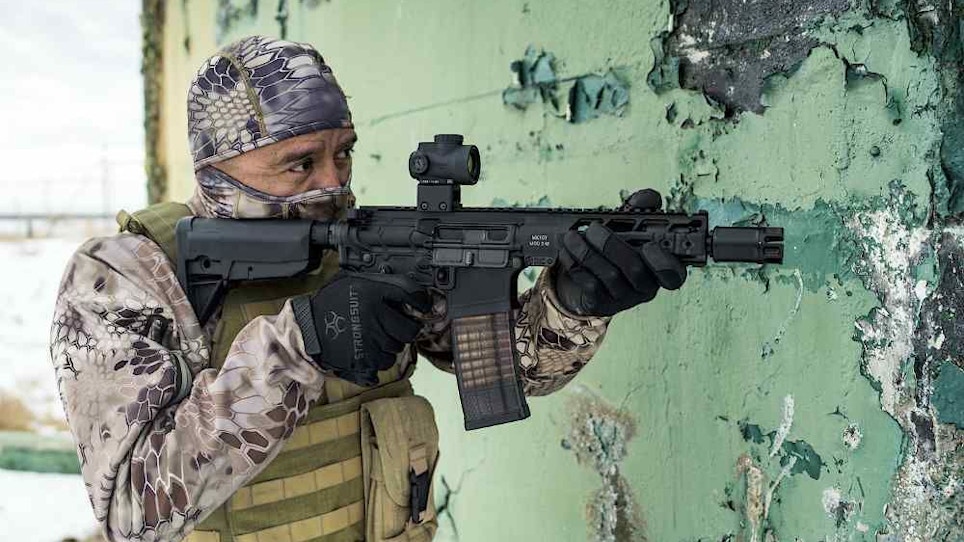
The MK1 MOD 2 platform is available in SBR, pistol and rifle length in .223 Wylde, .300 Blackout or 7.62x39.
This interview with Dean Sylvester — President and CTO for Primary Weapons System (PWS), could have generated a mid-length novel on gas and piston systems.
PWS became well known for its premier tier of long-stroke gas piston AR-15s with leading edge innovation and its highly durable piston-driven uppers and rifles. Many have remarked that PWS represent the pinnacle of design, materials, innovation and AR-15 features in an unapologetic, no-expense-spared manufacturing process. Their top tier AR-15s carry an MSRP of more than $2,000, but once customers understand all the nuanced custom parts they become PWS fans for life.
As an owner of three PWS rifles and pistols, I have been exceptionally impressed with my own failure-free 5,000+ round testing of my original PWS .223 Wylde pistol. Maintenance, cleaning or lubrication of any kind was intentionally neglected. Sylvester is always excited to share how Primary Weapons Systems started and why he believes his long-stroke piston system has developed an extensive cult following.
TR— How did PWS begin?
DS— I wish I could say that our adventure was all well thought out and planned, but it was a meandering path I blame on the ATF, starting in 2008. I had a real job and also had an existing home FFL license and SOT. An ATF inspection noted that new ATF regulations would require a commercial location for my FFL and SOT business. A commercial space was acquired and we started making Yugoslavia AMD 65 AK kits to make the real estate investment worthwhile. We were building so many AK rifles that we even started bending our own receivers, but we needed a longer compensator to pin in place to make the short AMD barrels legal length. At that time, no one was making brakes for cheap AK kit rifles, so we started making our own and that became the JTAC 47 comp we still sell today.
The old AK brakes were a simple angled slant that clocked vented gas at about two o’clock so we played around with two different prototypes and settled on the current JTAC 47 design. Some of the AR-15 guys in the shop wanted the comp for the AR-15. It took a whopping 40 prototypes to get the AR-15 version tuned right, which later became the FSC comp. Miculek brakes were hot sellers, and highly effective, but were uncomfortable to shoot behind or around and did nothing to kill flash. Our flash hiding comps were really the first to hit the market that were not unbearable to shoot around and also killed the flash. We knew we had something; and we started asking ourselves, “Why not quit our jobs and do this full time?” So we did and patented the designs.
TR— With all that expertise with AKs, how is it that PWS ended up making long-stroke piston systems?
DS — Another meandering path spurred by a need to demo our AR-15 compensators. We could not get a direct impingement AR to get through an entire Beta mag without some type of failure. Even one failure during a demo is certainly not an impressive demo. We seemed to be spending more shop time working on keeping the demo guns working than we were demoing. We did not see these problems even in full-auto with long-stroke gas piston system on the AKs, so we saw an opportunity in the AR-15 market. At that time, POF and H&K were working on their short-stroke systems and having a lot of reliability issues with carrier tilt, overgassing and dwell time; our long-stroke system did not have those issues and was already proven in the AK.
My perspective was if we really want to show how a long-stroke gas piston system can work better in an AR, we should prove it in one of the most problematic AR-15 formats — a full-auto-rated 7-inch barreled gun. We learned a lot about the AK and AR formats along the way. What were the weak points and the strengths of each design. We took that knowledge and inevitably developed the 7-inch barreled SBR Diablo, which proved our piston system to the market.
Customers and editors loved it because it was incredibly soft shooting and just plain worked and kept working despite neglected cleaning and lubrication, which was a feat other piston and DI rifles competitors could not show in a SBR. The Diablo concept pushed us further into full rifles, to be able to control all the aspects of quality and manufacturing with the mindset that guns make you cool and parts make you money.
What set us apart then and now was gas block dwell time and attention to all the little details. We started designing a lot of our own parts, but used some outside manufacturing. When the burst hit in 2010, we could not get parts reliably and they were hit or miss in quality. We had everyone, including the big guys like DPMS, calling us to get parts. That put things into perspective. We were not going to get product if DPMS, who was willing to pay a premium, could not. We made the decision to insource all our manufacturing and now even have our own Mil-Spec-compatible, proprietary lightened forged upper and lowers and are no longer dependent on external manufacturing for our core products. Everything started to get produced in-house at that point, and we were able to accelerate many of our product designs.
TR — Can you talk about some of your unique parts?
DS— We have a lot. Beyond our long-stroke gas piston system, we have our own lightened upper and ambi lower receivers you see on our MOD 2 rifles and pistols. The handguard is very unique with a very small diameter profile and our Piclock Rail system reduces light mounting offset on the rail. The PPC Glock compatible 9mm rifles/pistols. Our buffer tube is 1-ounce lighter than Mil-Spec tubes and ours tends to be quieter due to the internal burnishing to make it smoother. Our buffers are made of steel instead of aluminum and optimized to reduce friction. We agonize over every part from the muzzle to the buffer tube. Our ratcheting castle nut is also unique and cool, but it too addresses a significant problem of castle nut movement.
TR — What was the new product that launched PWS?
DS — The FSC flash hider on the FN SCAR rifles and all the others that we have sold. The FSC has been on the market for 10 years and has been continuously noted as one of the best combo brake/flash hiders on the market and, including all SCARS, there are now over 200,000 in circulation. That one compensator allowed us to focus on the things we wanted to do, which was developing the most refined and reliable AR format in the world.
TR— What makes a PWS rifle or pistol different than everyone else in the market with “a better AR-15?”
DS— That is a fair question that is not easy to answer simply. We are not the cheapest by far, but we believe we have the best rifle made. We put a ton of design into making every part look cool, however the intent first and foremost is to increase reliability and decrease weight and friction — cool is a design by-product. We learned a lot with all those AK kits and AR demo rifles. Our focus has been a no-expense-spared approach to every little component in the AR and that started with the long-stroke gas piston system and longer dwell time.
Reliability was the sole focus for developing our piston system. Our long-stroke gas piston is similar to the AK, but is different than any other on the market because it is one of the few long-stroke systems focusing on maximizing dwell time — essentially the delay before cycling occurs. The dwell is everything and is one reason that our rifles have been noted as the softest recoiling full-auto-rated AR-15s on the market.
Basically, we have extra air space inside our gas block to provide a few extra milliseconds of delay before cycling starts, which in turn softens felt recoil and reduces a lot of requirements for AR fixes and failures. DI guns have to build pressure in the gas tube each time, which creates a natural dwell time. On piston guns, the gas is pushing a piston that is mechanically connected to the carrier and, if not tuned right, it can be very hard on all the components and the shooter. Our three-position gas block is the easiest in the industry for the suppressor shooter and also works to maximize dwell time. Beyond the piston, we do a lot of other details such as use super hard lithium isonate-coated S7 steel for the bolt carrier group for ultimate durability.
We also focus on giving crud a place to go — it will find a way in the gun so you might as well plan for a place for it to collect that will not impact functioning. Our gas piston systems have demonstrated over and over that they can go for thousands and thousands of rounds without failure with no lubrication or cleaning. We saw our DI AR demo rifles could typically go for a few hundred rounds before requiring lubrication and thousand rounds or so before functioning degrades requiring both cleaning and lubrication. We have many shooters who note our piston rifles have gone for over 8,000 rounds without cleaning or lubrication. With our piston system, a very limited amount of crud is blown back into the action even when suppressed, so our actions can run exponentially longer without cleaning.
The next piece of our secret sauce is reducing friction everywhere on the rifle. All the moving parts have some type of friction reducing nitriding or lithium isonate coating. The carrier, buffer, buffer tube, upper, bolt and barrel extension are all painstakingly designed to reduce friction. We even have a little spring behind our bolt in the carrier to assure the bolt always indexes perfectly even during extended full-auto fire. It is all these details that make customers loyal to the PWS brand and not just the cool factor.
TR — What are your top selling products?
DS— Our new PCC 9mm Glock magazine-compatible carbine and pistols have been huge sellers, but our 16- and 11-inch 5.56 MOD 2 and MOD1 AR-15s sell more than any of the other firearms combined. For suppressors, 11-inch is a good compromise for complete powder burn and a cleaner running platform. Our number one seller by a mile is our buffer tube and ratchet lock castle nut set.
TR — How can dealers work with PWS?
DS— We can work direct or through RSR, Bill Hicks or Sports South — whatever dealers feel comfortable with. Direct stocking dealers in the $150,000 yearly range receive additional POS support and one of our cutaway guns for floor demos. We are MAP-regulated pricing, but we want to work with dealers and distributors on some MAP price holidays for special promos.
TR— What is next for PWS?
DS— The next product line will be our “Pro Line,” which will be a PWS MOD 1 piston gun for the semi-auto shooter. These sub-$1,000 complete guns will feature lower cost extruded receivers with no forward assist and ambi charging handles. Pro Line uppers will be available for $650 MAP. This will be one of the first piston ARs under $1,000 to hit the market and we believe it will do exceptionally well.






